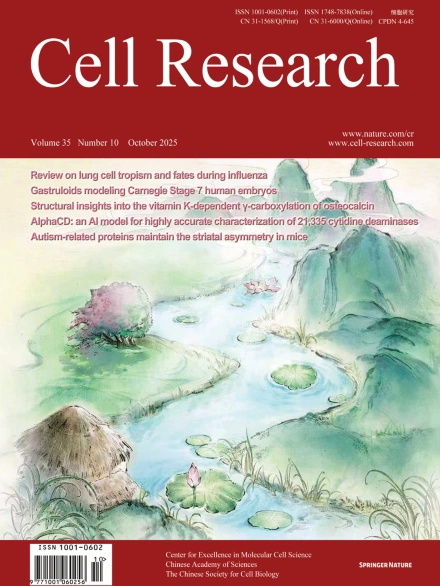
Advanced Search
Submit Manuscript
Advanced Search
Submit Manuscript
Volume 35, No 10, Oct 2025
ISSN: 1001-0602
EISSN: 1748-7838 2018
impact factor 17.848*
(Clarivate Analytics, 2019)
Volume 35 Issue 10, October 2025: 735-749
Structural insights into the vitamin K-dependent γ-carboxylation of osteocalcin
Qing Cao1,† , Jianjun Fan1,† , Aaron Ammerman1 , Samjhana Awasthi1 , Zongtao Lin1 , Saimi Mierxiati1 , Huaping Chen2 , Jinbin Xu2 , Benjamin A. Garcia1 , Bin Liu3,* , Weikai Li1,*
1Department of Biochemistry and Molecular Biophysics, Washington University School of Medicine, St. Louis, MO, USAThe γ-carboxylation state of osteocalcin determines its essential functions in bone mineralization or systemic metabolism and serves as a prominent biomarker for bone health and vitamin K nutrition. This post-translational modification of glutamate residues is catalyzed by the membrane-embedded vitamin K-dependent γ-carboxylase (VKGC), which typically recognizes protein substrates through their tightly bound propeptide that triggers γ-carboxylation. However, the osteocalcin propeptide exhibits negligible affinity for VKGC. To understand the underlying molecular mechanism, we determined the cryo-electron microscopy structures of VKGC with osteocalcin carrying a native propeptide or a high-affinity variant at different carboxylation states. The structures reveal a large chamber in VKGC that maintains uncarboxylated and partially carboxylated osteocalcin in partially unfolded conformations, allowing their glutamate-rich region and C-terminal helices to engage with VKGC at multiple sites. Binding of this mature region together with the low-affinity propeptide effectively stimulates VKGC activity, similar to high-affinity propeptides that differ only in closely fitting interactions. However, the low-affinity propeptide renders osteocalcin prone to undercarboxylation at low vitamin K levels, thereby serving as a discernible biomarker. Overall, our studies reveal the unique interaction of osteocalcin with VKGC and provide a framework for designing therapeutic strategies targeting osteocalcin-related bone and metabolic disorders.
https://doi.org/10.1038/s41422-025-01161-0